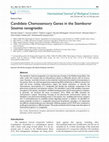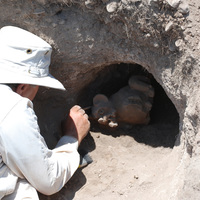Papers by E. Jacquin-joly

International Journal of Biological Sciences, 2013
The stemborer Sesamia nonagrioides is an important pest of maize in the Mediterranean Basin. Like... more The stemborer Sesamia nonagrioides is an important pest of maize in the Mediterranean Basin. Like other moths, this noctuid uses its chemosensory system to efficiently interact with its environment. However, very little is known on the molecular mechanisms that underlie chemosensation in this species. Here, we used next-generation sequencing (454 and Illumina) on different tissues from adult and larvae, including chemosensory organs and female ovipositors, to describe the chemosensory transcriptome of S. nonagrioides and identify key molecular components of the pheromone production and detection systems. We identified a total of 68 candidate chemosensory genes in this species, including 31 candidate binding-proteins and 23 chemosensory receptors. In particular, we retrieved the three co-receptors Orco, IR25a and IR8a necessary for chemosensory receptor functioning. Focusing on the pheromonal communication system, we identified a new pheromone-binding protein in this species, four candidate pheromone receptors and 12 carboxylesterases as candidate acetate degrading enzymes. In addition, we identified enzymes putatively involved in S. nonagrioides pheromone biosynthesis, including a ∆11-desaturase and different acetyltransferases and reductases. RNAseq analyses and RT-PCR were combined to profile gene expression in different tissues. This study constitutes the first large scale description of chemosensory genes in S. nonagrioides.

Frontiers in Ecology and Evolution, 2015
In moths, mate finding strongly rely on the detection of sex pheromones by pheromone receptors (P... more In moths, mate finding strongly rely on the detection of sex pheromones by pheromone receptors (PRs). Any modification in the functional properties of these receptors can have a drastic impact on reproduction. In the course of characterizing candidate PRs in the noctuid moth Spodoptera littoralis, we expressed them in Drosophila olfactory sensory neurons and stimulated them with a large panel of moth pheromone compounds. We found that two PRs detect (Z,E)-9,12-14:OAc, a minor component of the female pheromone blend. Whereas SlitOR6 is highly specific to this component, SlitOR13 is less sensitive and not strictly specific as it also detects (Z)9-14:OAc, another minor component of the sex pheromone. Interestingly, SlitOR13 expression is restricted to the distal part of male antennae, where we could identify a novel functional class of pheromone-sensitive neurons whose response spectrum matches that of SlitOR13. Based on a phylogenetic analysis of Lepidoptera PRs, we found that the ability to bind (Z,E)-9,12-14:OAc appeared independently within three paralogous lineages, and an analysis of selective pressures revealed sites under positive selection that could have played a role in the emergence of functional properties of OR6 and OR13 in Spodoptera species.

BMC Genomics, 2014
Background: Spodoptera frugiperda (Noctuidae) is a major agricultural pest throughout the America... more Background: Spodoptera frugiperda (Noctuidae) is a major agricultural pest throughout the American continent. The highly polyphagous larvae are frequently devastating crops of importance such as corn, sorghum, cotton and grass. In addition, the Sf9 cell line, widely used in biochemistry for in vitro protein production, is derived from S. frugiperda tissues. Many research groups are using S. frugiperda as a model organism to investigate questions such as plant adaptation, pest behavior or resistance to pesticides. Results: In this study, we constructed a reference transcriptome assembly (Sf_TR2012b) of RNA sequences obtained from more than 35 S. frugiperda developmental time-points and tissue samples. We assessed the quality of this reference transcriptome by annotating a ubiquitous gene family-ribosomal proteins-as well as gene families that have a more constrained spatio-temporal expression and are involved in development, immunity and olfaction. We also provide a time-course of expression that we used to characterize the transcriptional regulation of the gene families studied. Conclusion: We conclude that the Sf_TR2012b transcriptome is a valid reference transcriptome. While its reliability decreases for the detection and annotation of genes under strong transcriptional constraint we still recover a fair percentage of tissue-specific transcripts. That allowed us to explore the spatial and temporal expression of genes and to observe that some olfactory receptors are expressed in antennae and palps but also in other non related tissues such as fat bodies. Similarly, we observed an interesting interplay of gene families involved in immunity between fat bodies and antennae.
Archives of Insect Biochemistry and Physiology, 1999
A direct enzyme-linked immunosorbent assay has been developed and applied to the analysis of PBAN... more A direct enzyme-linked immunosorbent assay has been developed and applied to the analysis of PBAN immunoreactivity in female hemolymph of the cabbage armyworm, Mamestra brassicae. PBAN-IR determinations have been carried out with third scotophase insects at different times of the photoperiod. The rhythm of calling and the pattern of pheromone production by third scotophase females at different times of the photoperiod have also been determined. PBAN-IR and calling are well correlated. However, whereas pheromone titers decrease, both PBAN-IR levels and percentage of calling females remain high in the last hours of the scotophase. These results are discussed in the context of the regulation of sex pheromone biosynthesis in M. brassicae. Arch. Insect Biochem. Physiol. 40:80-87, 1999.
Communications Biology, 2021
In the original version of the Article, the project accession codes for the genome assembly and f... more In the original version of the Article, the project accession codes for the genome assembly and for the umbrella project were omitted. The Data availability statement should read "The datasets and genomes generated during the current study are available from the European Bioinformatic Institute (EMBL-EBI) and National Center for Biotechnology Information (NCBI) at the following BioProject IDs: PRJEB36310 and PRJEB43234 (umbrella project PRJEB40240). Genome database (genomes and annotated genes) is also available on the web site BIPAA (Bioinformatic Platform for Agrosystem Arthropods) https://bipaa.genouest.org/is/parwaspdb/".

Frontiers in Ecology and Evolution, 2014
Plant volatiles mediate host discrimination and host finding in phytophagous insects. Understandi... more Plant volatiles mediate host discrimination and host finding in phytophagous insects. Understanding how insects recognize these signals is a current challenge in chemical ecology research. Pear ester, ethyl (E,Z)-2,4-decadienoate, is a powerful, bisexual attractant of codling moth Cydia pomonella (Lepidoptera, Tortricidae) and strongly synergizes the male response to female-produced sex pheromone. We show here that the codling moth odorant receptor (OR) CpomOR3 is dedicated to detecting this plant volatile. Heterologous expression of CpomOR3 in Drosophila T1 trichoid and ab3A basiconic sensilla, followed by a screening with codling moth pheromone compounds and known plant volatile attractants, confirms that CpomOR3 binds to pear ester. Although CpomOR3 does not respond to any of the pheromone components tested, a phylogenetic analysis of lepidopteran chemosensory receptor genes reveals a close relationship of CpomOR3 with pheromone receptors (PRs) in moths. This corroborates the interaction of ecological and social chemosensory cues during premating communication. The finding that a plant volatile compound, pear ester, is a specific ligand for a PR-like lepidopteran receptor adds to our understanding of insect-plant interactions and emphasizes the interaction of natural and sexual selection during the phylogenetic divergence of insect herbivores.
Nature, 2012
Butterfly genome reveals promiscuous exchange of mimicry adaptations among species The Heliconius... more Butterfly genome reveals promiscuous exchange of mimicry adaptations among species The Heliconius Genome Consortium*
Insect Molecular Biology, 2008
In the aim of the characterization of the molecular actors of insect olfactory transduction, we h... more In the aim of the characterization of the molecular actors of insect olfactory transduction, we have cloned the full cDNA encoding a Spodoptera littoralis diacylglycerol kinase (DGK) named SlDGK. In male adults, SlDGK transcript was detected predominantly in the brain and in the olfactory sensilla trichodea located on the antennae. SlDGK expression was first detected at day 3 of the pupal stage, then reached a maximum at the end of this stage and was maintained at this level during the adult period. These data provide the first molecular characterization of a DGK potentially involved in the regulation of signalling pathways responsible for the establishment and/or the functioning of the olfactory system in Lepidoptera.

Chemical Senses, 2000
Soluble, low molecular weight proteins were immunodetected in proboscis extracts of Mamestra bras... more Soluble, low molecular weight proteins were immunodetected in proboscis extracts of Mamestra brassicae males by Western blot, using antibodies raised against the general odorant-binding protein of the moth Antheraea polyphemus. The same antibodies weakly labelled the sensillum lymph and subcuticular space of sensilla styloconica on ultrathin sections of the proboscis. The morphology of sensilla styloconica is described. The immunodetected proteins yielded several N-terminal sequences, three of which showed strong affinity for tritiated analogues of pheromonal compounds of M. brassicae in binding assays. The cDNAs coding for these sequences were cloned and it was shown that the new proteins are related to the OS-D protein of Drosophila. They are named chemosensory proteins (CSP-MbraA1-CSP-MbraA5 and CSP-MbraB1 and CSP-MbraB2) and may have an odorant-binding protein-like function. A common localization in both olfaction and taste organs suggests a physiological role depending on the cellular environment.

Chemical Senses, 2001
Sequences coding for chemosensory proteins (CSP) CSPMbraA and CSPMbraB, soluble proteins of low m... more Sequences coding for chemosensory proteins (CSP) CSPMbraA and CSPMbraB, soluble proteins of low mol. wt, have been amplified using polymerase chain reaction on antennal and pheromonal gland complementary DNAs. On the basis of their sequences, these proteins could be classed in the 'OS-D like' protein family whose first member was described in Drosophila, and that includes proteins characterized in chemosensory organs of many insect phylla, including our recent identification in Mamestra brassicae proboscis. Binding assays have shown that these proteins bind the pheromonal component (Z)-11-hexadecenyl-1-acetate (Z11-16:Ac) as well as (Z)-11-octadecenyl-1-acetate (Z11-18:Ac), an other putative component of the M. brassicae pheromonal blend. Furthermore, binding with fatty acids, but not with progesterone that is a structurally unrelated compound, leads to the hypothesis that the odorant-binding capability of the MbraCSPs may be restricted to fatty acids and/or to 16-18 carbon backbone skeletons. Thus, these proteins do not show the same highly binding specificity as the pheromone-binding proteins do. The CSP-related proteins appear homologous based on sequence identity, conserved cysteine residues and general patterns of expression. However, phylogenetic analyses suggest the presence of multiple classes of CSP within a given species and possible diversification of CSPs within different orders. This diversity perhaps contributes to the many CSP functions proposed in the literature. In M. brassicae, we localized the CSPMbraA expression to the sensilla trichodea, devoted to pheromone reception, suggesting a role in the chemosensory pathway. However, we also localized such proteins in the pheromonal gland, devoid of any chemosensory structure. This suggests that the M. brassicae CSP could be involved in transport of hydrophobic molecules through different aqueous media, such as the sensillar lymph, as well as the pheromonal gland cytosol.

Proceedings of the National Academy of Sciences, 2004
Previous biochemical evidence suggests that a cytochrome P450 specific to male antennae of the pa... more Previous biochemical evidence suggests that a cytochrome P450 specific to male antennae of the pale-brown chafer, Phyllopertha diversa , has evolved as a pheromone-degrading enzyme. By using a bioinformatics approach, we have now cloned three P450 cDNAs: CYP4AW1, CYP4AW2, and CYP6AT1. RT-PCR indicated that CYP4AW2 is expressed in all tissues examined, that CYP6AT1 is antennae-rich, and that CYP4AW1 is antennae-specific. Both tissue specificity and electrophysiological studies strongly support that CYP4AW1 in P. diversa is a pheromone-degrading enzyme involved in pheromone inactivation. Highly sensitive, pheromone-specific olfactory receptor neurons in male antennae were completely desensitized by direct application of metyrapone into the sensillar lymph. When tested in the same or different individuals, the metyrapone treatment had no effect on olfactory receptor neurons tuned to the plant volatile ( Z )-3-hexenyl acetate, which might be inactivated by an esterase. Metyrapone treatm...

Insect Molecular Biology, 2010
A new family of candidate chemosensory ionotropic receptors (IRs) related to ionotropic glutamate... more A new family of candidate chemosensory ionotropic receptors (IRs) related to ionotropic glutamate receptors (iGluRs) was recently discovered in Drosophila melanogaster. Through Blast analyses of an expressed sequenced tag library prepared from male antennae of the noctuid moth Spodoptera littoralis, we identified 12 unigenes encoding proteins related to D. melanogaster and Bombyx mori IRs. Their full length sequences were obtained and the analyses of their expression patterns suggest that they were exclusively expressed or clearly enriched in chemosensory organs. The deduced protein sequences were more similar to B. mori and D. melanogaster IRs than to iGluRs and showed considerable variations in the predicted ligand-binding domains; none have the three glutamate-interacting residues found in iGluRs, suggesting different binding specificities. Our data suggest that we identified members of the insect IR chemosensory receptor family in S. littoralis and we report here the first demonstration of IR expression in Lepidoptera.
Insect Molecular Biology, 2007
Rapid degradation of odours after interaction with olfactory receptors is a critical step of the ... more Rapid degradation of odours after interaction with olfactory receptors is a critical step of the signal reception process. However, the implied mechanisms are still largely unknown in vertebrates as well as in insects. Involvement of odourant-degrading enzymes in odourant degradation within the antennae has been shown in some insect species and, in particular, esterases could play a key role in degradation of sex pheromones from Lepidoptera. Using a PCR-based strategy, we isolated cDNAs encoding two new esterases from two moths which used acetates as pheromone compounds: the Egyptian armyworm Spodoptera littoralis and the Mediterranean corn borer Sesamia nonagrioides. In antennae, both transcripts were clearly restricted to olfactory sensilla, suggesting their involvement in the degradation of odourant acetate components.

Nature Communications, 2012
sex pheromones are released by adults of a species to elicit a sexual interaction with the other ... more sex pheromones are released by adults of a species to elicit a sexual interaction with the other sex of the same species. Here we report an unexpected effect of a moth sex pheromone on the caterpillars of the same species. We demonstrate that larvae of the cotton leafworm Spodoptera littoralis are attracted by the moth sex pheromone and that this phenomenon is independent of sex determination. In addition, we show that the olfactory sensilla carried by the caterpillar antennae are sensitive to the pheromone and that the caterpillar sensilla express pheromone-binding proteins that are used by adult antennae to bind pheromone components. Finally, we demonstrate that the larvae are preferentially attracted to a food source when it contains the sex pheromone main component. A possible interpretation of these results is that the sex pheromone is used to promote food search in caterpillars, opening potential new routes for insect pest management.

Insect Biochemistry and Molecular Biology, 2015
High Throughput Sequencing capabilities have made the process of assembling a transcriptome easie... more High Throughput Sequencing capabilities have made the process of assembling a transcriptome easier, whether or not there is a reference genome. But the quality of a transcriptome assembly must be good enough to capture the most comprehensive catalog of transcripts and their variations, and to carry out further experiments on transcriptomics. There is currently no consensus on which of the many sequencing technologies and assembly tools are the most effective. Many non-model organisms lack a reference genome to guide the transcriptome assembly. One question, therefore, is whether or not a reference-based genome assembly gives better results than de novo assembly. The blood-sucking insect Rhodnius prolixus-a vector for Chagas disease-has a reference genome. It is therefore a good model on which to compare reference-based and de novo transcriptome assemblies. In this study, we compared de novo and reference-based genome assembly strategies using three datasets (454, Illumina, 454 combined with Illumina) and various assembly software. We developed criteria to compare the resulting assemblies: the size distribution and number of transcripts, the proportion of potentially chimeric transcripts, how complete the assembly was (completeness evaluated both through CEGMA software and R. prolixus proteome fraction retrieved). Moreover, we looked for the presence of two chemosensory gene families (Odorant-Binding Proteins and Chemosensory Proteins) to validate the assembly quality. The reference-based assemblies after genome annotation were clearly better than those generated using de novo strategies alone. Reference-based strategies revealed new transcripts, including new isoforms unpredicted by automatic genome annotation. However, a combination of both de novo and reference-based strategies gave the best result, and allowed us to assemble fragmented transcripts.
European Journal …, 1998
A cDNA clone encoding a general odorant-binding protein (GOBP2) was isolated from antennal RNA of... more A cDNA clone encoding a general odorant-binding protein (GOBP2) was isolated from antennal RNA of Mamestra brassicae by reverse transcription-PCR (RT-PCR) and RACE-PCR. The cDNA encoding the GOBP2 was further used for bacterial expression. Most of the recombinant ...









Uploads
Papers by E. Jacquin-joly